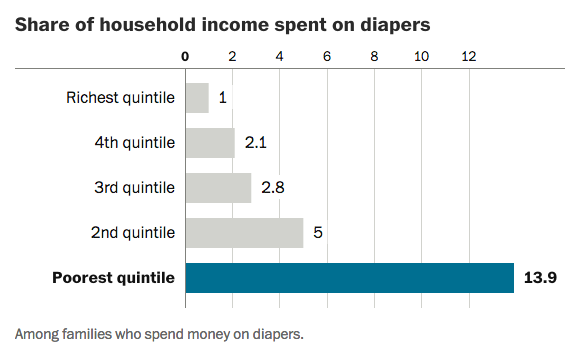In last few months especially, there has been a big media push in favor of creating a new diaper welfare program. The push seems to have its origins in 2010, when the Huggies diapers brand commissioned a study showing the need for diapers among the poor. In that same year, Huggies founded the National Diaper Bank Network (NDBN), which was headquartered in New Haven, Connecticut. Kimberly-Clark, the maker of Huggies, also has a large production facility in nearby New Milford, Connecticut. A year after the NDBN was formed, in 2011, CT representative Rosa DeLauro first introduced the DIAPER Act in the House (cosponsored by 3 of the other 4 CT representatives, among 16 others) and CT Senator Richard Blumenthal introduced the same bill in the Senate (with no cosponsors).
The exact contours of the desired diaper welfare program are unclear, but proposals I’ve seen include block granting money to states so that they can provide actual physical diapers in-kind to people in need and a SNAP-like system where diapers could be bought using EBT cards. While this is all obviously well intended, it’s also amazingly absurd at the same time.
The crux of the argument for a means-tested, in-kind diaper program is summed up by this graph based on the Current Expenditure Survey.

Since diapers cost the same whether you are poor or rich, it turns out that when you divide diaper expenditures by income, those with lower incomes end up spending a greater share of it on diapers than those with higher incomes. It may also be the case, though evidence on this front is not forthcoming, that poorer people spend more money per diaper for the usual “being poor is expensive” reasons — can’t shop in bulk, nearby retail is sparse and heavily marked up, etc.
The argument that many families with young children don’t have enough income to meet their basic needs is obviously well taken by me. You don’t need to divide diaper expenditures by income to prove that. A glance at the child poverty statistics is more than enough evidence on that front.
But the question is what should we do about this? Should we really create a new block grant or SNAP-like program to provide means-tested, in-kind diapers? Do we really need another one of these “commodities” type programs? Is it smart to have people lose their diaper supply when they receive more income, along with their food stamps and healthcare (Medicaid)?
The answer is of course no.
If you want to offset the costs of diapers for parents of young children, that can be done extremely easily by simply giving every single family with young children a cash payment each month equal to the cost of diapers.
In the Washington Post piece on the topic, Luke Tate is quoted as saying some people spend as much as $1,000 per year on diapers. So let’s use that figure and say each family will receive approximately $83/month for every child under 3 in their family. According to the 2015 ASEC, there are approximately 15.9 million children under the age of 3 in the US. If you multiply that by the $1,000 per child, that’s $15.9 billion, which is equal to slightly less than 0.09% of GDP. For a fiscal rounding error, you coud give every single family in the country enough money to pay for diapers.
Regular readers will know that this cash-for-diapers program is just a type of child allowance, a topic The Century Foundation recently released an excellent paper on. This is the direction we should be going for providing resource boosts to families with children (especially young children), not more bizarre means-tested, in-kind deliveries of particular commodities. The child allowance is clean, easily administered, and universal. Diaper stamps is a kludge that will involve much higher administration costs and create weird means-tested cliffs that make life miserable for low-earners while also unnecessarily thinning out the program’s constituency.